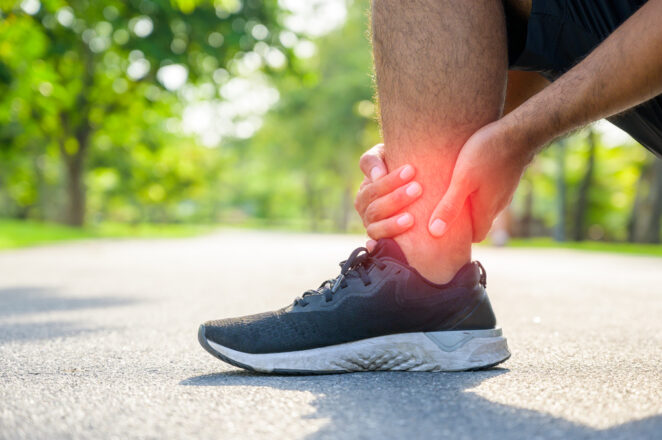Do your ankles hurt when running? And are you feeling some ankle pain after running too?
Many runners experience ankle pain at some point. Understanding the potential causes helps you get the best treatment and avoid serious injury.
In this post, we’ll look at the causes that may make you feel ankle pain while running. We’ll also show you what to do if your ankle hurts after running constantly.
In This Article:
Why Do My Ankles Hurt Running?
Did you know that the average runner moving at a pace of 6 miles per hour takes 1,700 steps per mile? That puts significant strain on your ankles.
Other factors can further add to the strain: a high body mass index, worn-out running shoes, or a hard surface.
That said, you won’t get sore ankles after running or during your workout unless there’s an underlying cause.
Let’s take a closer look at the most common ankle injuries to understand what causes ankle pain most of the time.
Sprain
Often, when runners ask themselves, “Why do my ankles hurt after running?” the first answer is: ankle sprain.
Causes
An ankle sprain occurs when you overstretch or tear a ligament. The culprits are usually the external or lateral ligaments in the foot.
Ankle sprain tears may be partial or complete. The intensity of the pain and other symptoms depend on the type of tear. Ankle sprains get better with rest.
Ankle sprains often happen accidentally when you roll your foot inward or twist it.
Symptoms
Typical ankle sprain symptoms include pain and swelling. You won’t be able to use your ankle, and the pain can be intense. Bruising may also appear. The good news is that ankle sprains get better with rest.
What to do
Running on a sprained ankle is possible but not a good idea. Take a break from running to let your ankle rest and treat your injury (more about this later). Don’t return to running until after you’re pain-free.
Strain
The second most common answer to “Why do my ankles hurt when I run?” is ankle strain.
Causes
You may get ankle strain if you overstretch or tear a tendon. While ligaments connect two or more bones, tendons connect muscles to bones.
Like sprains, strains can occur because of repeated stress on your leg. Or because of a bad movement or traumatic injury while running.
Symptoms
Ankle strain symptoms include pain, swelling, and possibly cramping and muscle spasms. Moving your ankle becomes painful and difficult after having a strain.
What to do
While you may still run with a mild ankle strain, it’s best to rest. You want to be pain-free before returning to the trail.
Stress fracture
Stress fractures commonly affect long-distance runners. They can cause ankle pain while running as well as when walking or standing.
Causes
Running too much or too hard can cause tiny cracks in the bones of your feet and legs. When this happens, you may get a more serious case of the runner’s ankle. The specific causes of a stress fracture typically are:
- Running too much or too often
- Changing running surfaces such as going from a track to pavement
- Lacking key nutrients for runners such calcium or vitamin D
- Not training all your body muscles so that they can better support your weight when running
Symptoms
Stress fracture pain can grow in intensity after your run, but it typically lessens with rest. You may also notice swelling and bruising.
What to do
Rest is crucial to prevent a stress fracture from getting worse. If you keep running with a stress fracture, you may end up getting sidelined for months.
Tendonitis
If you’re asking yourself, “Why does my ankle hurt when I walk in the morning?” – it’s probably tendonitis or tendinitis. Different foot or leg tendons may be affected, including the Achilles, tibialis, peroneal, or posterior tibial tendon.
When the latter is involved, you’re more likely to feel inner ankle pain running. Depending on the injured tendon, you may also get shin splints or runners heel.
Causes
Tendonitis occurs when one of your tendons becomes inflamed or irritated. If you’re thinking overtraining is the reason, you’re right. Running too much often causes it. Other causes include having flat feet or low arches and wearing bad running shoes.
Symptoms
Tendonitis symptoms can occur when running. But you’ll often feel them later when you try to move the ankle. You may feel pain in the morning when you get down from the bed.
However, a large swollen ankle after running is not a typical symptom of tendonitis. Swelling with this condition is only limited. If your swelling is bad, look for other causes.
What to do
The most important thing when you suffer from tendonitis after running is to stop running and rest.
Ankle arthritis
Arthritis doesn’t affect only older people. In rare cases, feeling ankle pain when running may be an early sign of this condition.
Causes
Different types of arthritis may affect the ankle joint, including rheumatoid arthritis and osteoarthritis. Arthritis in the ankle may also occur because of ankle trauma (post-traumatic arthritis). Repeated pressure on the ankle from long-distance running may make the condition worse.
Symptoms
Ankle arthritis symptoms include pain when walking or running. The pain may return after rest and get progressively worse. The joint may be stiff and swollen.
What to do
It’s best to see a doctor. Experiencing ankle pain as a result of arthritis doesn’t mean you can’t run. But it’s important to check with your doctor for treatment plans and other recommendations.
Causes of Ankle Injury and Ankle Pain
A 2015 systematic review of running injury risk factors found that repetitive stress causes 80% of running injuries.
As we’ve seen, ankle conditions that can make you feel ankle pain running can have different causes. But often, ankle injury and pain causes are common and preventable.
They can be related to your gear, how you train, or how well you manage previous injuries.
Improper running shoes
Wearing worn-out or low-quality running shoes can increase your risk of ankle pain and running injuries. The same is true if you wear shoes not right for your type of feet. Having high arches or flat feet calls for special running shoes and orthotic inserts. It’s also good to choose shoes adapted to your type of pronation.
Previous injuries
If you keep on running with a mild ankle strain, you may end up with a torn tendon. Unhealed stress fractures can also lead to a larger, more painful fracture.
Other common running injuries such as the runner’s knee or runner’s heel may also change your running gait and lead to ankle pain. In other words, ankle pain while running often doesn’t come out of nowhere. It can be the result of earlier, unaddressed injuries.
Too much running
If you go from couch to intense training, you invite a variety of running injuries, including ankle injuries. The same is true if you suddenly increase your total weekly running by more than 10% from one week to another. Having a high body mass index compounds the risks.
Too little mobility
Ankle mobility refers to the strength and flexibility of your ankle joint and surrounding muscles, tendons, and ligaments. Some runners naturally have more ankle mobility than others. But often, ankle mobility is something you develop through training.
Sitting a lot or moving in the same plane of motion (long-distance running included) can limit ankle mobility. What you want to do is put your ankle through its full range of motion by incorporating ankle mobility exercises into your workout.
Tip: Lunges, ankle circles, single leg balance, and ankle stretches are some easy ankle mobility exercises you can do.
How to Treat Ankle Pain After Running
The best way to treat ankle pain after running is through the RICE approach. If you’ve dealt with running injuries in the past, you’re probably familiar with it. Let’s recap the main stages of this at-home treatment.
Rest
Stop running and other types of training that strain your ankle. Depending on the intensity of the pain, reduce or avoid putting weight on the ankle. If the pain is bad, don’t put weight on your ankle for at least 48 hours. Don’t run until your pain is fully gone.
Tip: Rest is also effective for ankle pain prevention. When you feel the strain on your ankle or the beginning of pain, rest.
Ice and cold therapy
Apply ice on the ankle as soon as you get home. Ice your ankle for 20 minutes between 4 and 8 times a day for 48 hours. If the swelling is bad, you can continue to ice the ankle until it subsides.
Tip: If you’re experiencing severe pain and inflammation, you may also consider using NSAIDs. Nonsteroidal anti-inflammatory drugs are available over the counter.
Compression
Use an ankle splint, compression sleeve, or wrap your ankle in kinesiology tape. Compression will help stabilize and support your ankle. It reduces swelling and can prevent movements that will make the pain worse.
Wearing an ankle splint at night can also accelerate the healing process. After your injury heals, consider using ankle support for running.
Elevate
Raise your ankle above your heart level when lying in bed or sitting. It will help reduce the swelling and promote faster healing. This is the excuse you’ve been waiting for to put your feet up the desk.
When to Seek Help
Most ankle pain will go away on its own, and you’ll be able to return to running. However, if the pain lingers or you experience other symptoms, it’s best to see your doctor. Seek help if:
- Your ankle pain lasts for more than 72 hours, whether it’s at the same intensity or worsens.
- You can’t put any weight on your ankle.
- You can’t return to running after following the RICE treatment for a week.
- You keep dealing with recurring ankle pain that interferes with running.
- Your ankle feels numb or becomes very red.
Takeaway
In the end, here are the key things to remember about ankle pain when running.
- Running puts unavoidable stress on your ankles, which may cause pain and swelling.
- Recurrent or severe ankle pain is often the result of overtraining.
- Other causes include running on hard surfaces, inappropriate running shoes, underdeveloped leg muscles, and poor nutrition.
- You can treat ankle pain with the RICE treatment method.
- Rest and wearing good running shoes can help prevent ankle injuries.
- Adding ankle strength and mobility exercises to your workouts reduces risks.
Your ankles take a lot of strain every day and bear it without complaint. But when you run too hard or for too long, it may tip the balance. Enjoy every run, but don’t overdo it!














